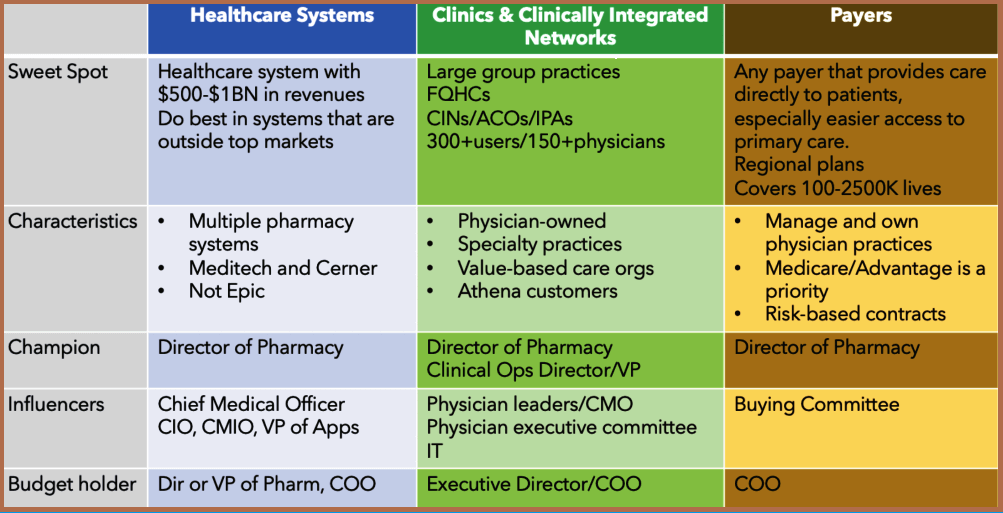In Account-based Marketing (ABM), targeting is fundamental. And your Ideal Customer Profile is the foundation of great targeting. Knowing how to create an ideal customer profile (ICP) is a critical skill to becoming a successful Account-based Marketer. In this post, we will share an example of an ideal customer profile framework.
What is an Ideal Customer Profile (ICP)?
In short, an ideal customer profile (ICP), sometimes known as an ideal buyer profile, defines your perfect customer. This is a fictitious company that has all of the qualities that would make them the best fit for the solutions you provide. In reality, you may have multiple ICPs, for example:
- Large regional hospital systems with over 1000 beds in aggregate
- Clinically-integrated networks with over 200 physicians
- Regional health insurance organizations that provide care directly to customers
Characteristics of Ideal Customer Profile
1. Customers With High Revenue Potential
Targets, prospects, or customers with the highest revenue potential are the most ideal for your business growth. What do they look like?
These customers have the greatest need and the budgets to pay to solve these issues. Seems obvious, right? The trick is NOT spending time on customers who have less need and don’t have the wherewithal to buy from you.
2. Shorter Average Sales Cycles
Given how long healthcare sales cycles last, this is an even more important attribute in healthcare than any other industry. This is more a wish than anything as it’s very hard to target based on this, but as you develop your strategy, take the time to consider what some organizations might buy faster than others. For example, when they have just acquired a new group of physicians, and there is an urgent need to integrate the organization.
The size of an organization can sometimes be a factor too as we discuss next.
3. Best-fit Industry Segment
This is harder than it sounds. There are obvious macro-segments, e.g., hospital systems, but which micro-segment should you be pursuing?
There is an art to deciding on this.
When creating the ICP for my clinical communications business, Uniphy Health, we determined that we were best suited to large regional healthcare systems. These were smaller than IDNs but larger than 3-4 hospital systems. We also met the needs of the newly emerging Accountable Care Organizations (ACOs) and their clinically integrated networks.
It took time to understand this, but once we did, we focused on these two with precision.
4. The Size of The Organization – Should be a perfect fit
You must focus on the company whose size is a perfect fit for the solutions you are providing. With Uniphy Health, we would target what we called “Goldilocks” hospitals. These were not too big and not too small. Not so big that they take forever to make a decision and not so small that they wouldn’t be able to afford our solution.
5. Geographical Location (Where applicable)
This attribute is determined by your ability to serve. If you sell a service that depends on having people in specific locations to serve the needs of patients locally, then clearly, geography will be more important than it is for a SaaS business where customers don’t need onsite support.
Another factor may be the stage of your business. In our early days with Uniphy Health, we decided to focus on customers we serve within driving distance. This was so we could build great references through high-touch service. In our first two years, we sold and serviced customers exclusively in the Northeast US.
Once we established this beachhead, we expanded based on the reach of our sales network.
6. Aligned With Your Company’s Objectives
Last but not least, is the prospect a fit for you? This may seem obvious, but it’s actually quite tricky. For example, if one of your objectives is to be the leader in your field, having references from the top IDNs like the Mayo Clinic will be a priority. If your objective is to be seen as an innovator, seeking out the most innovative healthcare systems will be important. If you are a mature company trying to expand from the provider market into the payer market, determining which payers are more likely to view your provider experience with providers will be key.
You cane use these six criteria to create your own ideal customer profile framework.
Important Note:
As you go through this process, addressability is a critical factor. Can you source data to help you pinpoint customers who meet these attributes? I will be writing more about this in a few weeks. As a simple filter, as you determine the criteria of your ICP, ask yourself a question, “Can I source data that will allow me to filter customers based on these criteria?” This will be important as you build your ideal customer profile framework.
How To Narrow Down Your ICP
Developing your ICP is about draining the swamp; eliminating the wrong targets will reveal the right targets. The trick is to remove prospects who would be unlikely to become profitable customers. As you refine your ICP, develop a set of disqualifying criteria.
Here are some examples.
1. Financial Viability & Stability
If your target customer is not financially stable or perhaps in the process of being acquired, you cannot rely on them for future businesses.
2. Ability To Sell To Them
You may aspire to have the Cleveland Clinic and other IDNs as your customers, but they are incredibly hard to sell to. If you don’t have the right people on your team and you can’t withstand very long sales cycles, selling to IDNs is not for you.
3. Relationships
If no one in your organization has a relationship with a potential prospect, maybe you should eliminate them for current consideration.
4. Competitors
You, obviously, need to know if a prospect has your competitor’s product. In some cases, that might disqualify them. For example, if they have recently purchased your competitor’s solution, they won’t be ready to switch.
Equally, if they have had your competitor for a while, they may be more open to switching. The key is to eliminate prospects from consideration who are happy customers
5. Third-party Related Barriers
Last but not least, what third-party issues disqualify the prospect from consideration? What EHR, they have is a great example of this. Epic customers are known for their zealous loyalty to them. However, I found that in my own business, organizations that had been Epic customers for a while were often easier to sell to than recent Epic customers.
We found that the longer-standing Epic customers valued them for many reasons but were often frustrated by the time it would take to get a specific feature. That would open them up to offers from outside the Epic tent.
How To Create An Ideal Customer Profile: Framework Example
To close with, below is an example of a made-up ideal customer profile framework I have used with my clients. This reflects the principles reviewed above.
 Fictionalized ICP
Fictionalized ICP
***********************
Other Insightful Posts:
Developing A Healthcare ICP – Real-World Case Study
Case Study: Developing An Ideal Customer Profile For B2B
Webinar Recording: How To Land a New Healthcare Client via Linkedln
Photo by Scott Graham on Unsplash

